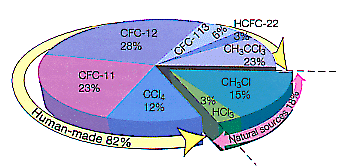PLAN OF ACTION ON THE OZONE LAYER
The first WMO intergovernmental scientific statement warning of the danger to the ozone layer. distributed in 1975, prepared the ground for legal action. In 1976, UNEP called for "an examination of the need and justification for recommending any national and international controls over the release of man-made chemicals". In the same year the UNEP Governing Council authorized convening a meeting of experts designated by governments, intergovernmental and non- governmental organizations (NGOs). WMO joined UNEP in the preparation and conduct of the meeting. held in Washington, DC, from 1 to 9 March 1977. WMO provided an 80- page "Survey of the state of knowledge of the ozone layer" with a series of proposals covering the monitoring of ozone and relevant rare species, data analysis, modelling and laboratory photochemistry, and UV-B measurements. UNEP laid the foundation for international action.
The representatives of 32 countries adopted the "World Plan of Action on the Ozone Layer". This 21 - point research plan covered the monitoring of ozone and solar radiation, the assessment of the effect of ozone depletion on human health. ecosystems and climate, and the development of ways of assessing the costs and benefits of control measures. WMO took responsibility for the atmospheric research plan. UNEP was given "a broad coordinating and catalytic role". By adopting the Action Plan, governmental experts accepted that there was a potential problem, though its extent had yet to be determined, and recommended actions to get to grips with it. In the same spirit, some countries soon took action to control CFCs; the USA, Canada, Norway and Sweden began phasing out their use in aerosol cans apart from essential medical and other uses. In 1980 the Commission of European Community agreed not to increase its capacity to produce CFCs 11 and 12 and called for a 30% cut in their use in spray cans by 1982.

|
Figure 19 -- The contributions to the overall chlorine loading of the atmosphere are mostly anthropogenic (82%) and only 18% from natural sources |
To review implementation of the Action Plan, UNEP set up a Coordinating Committee on the Ozone Layer. It comprised representatives of countries with major scientific programmes involved in the Action Plan, WMO, the World Health Organization and NGOS. The committee met regularly until the mid-1980s and became the focal point for international action. Hypothesis were debated by scientists and challenged by industry until the requirement for control of CFCs became accepted.
The Vienna Convention
Over the years, continued concern and and increased scientific information led to growing international acceptance of the need to take action to protect the ozone layer. In January 1982, UNEP convened the first meeting of an Ad hoc Group of Legal and Technical Experts for the Elaboration of a Global Framework Convention for the Protection of the Ozone Layer. WMO facilitated preparation of a detailed scientific review of the issue. The meeting identified the framework for a convention. After three years of extensive negotiations coordinated by UNEP, it was adopted in Vienna, March 1985. The 21 articles of the Convention pledge parties to protect human health and the environment from the effects of ozone depletion. Two annexes provide for participating states to co-operate in atmospheric ozone research, observations, and data and information exchange. In Vienna it was also agreed to work towards the preparation of concrete measures in the form of a protocol to the Convention.
The Montreal Protocol
The landmark Protocol on Substances that Deplete the Ozone Layer, which was adopted in Montreal (September 1987), called for 50% reduction of CFCs by the year 2000 (see box).
The Protocol contains a comprehensive schedule for phasing out the production and consumption as well as control measures on manufacturing, export and import of ozone depleting chemicals. The Parties to the Protocol also established panels of experts on scientific issues, environmental effects and on technical and economic assessments.
The Vienna Convention and its Montreal Protocol provide a dramatic example of science in the service of humankind. Atmospheric scientists had revealed the risk of halocarbons, allowing world leaders to take decisive action to protect the ozone layer.
Through active collaboration between WMO and UNEP, it became possible to achieve an important first in environmental management: to identify a threat and to take action to limit the extent of damage at an early stage before its effects were felt. The negotiations and agreements on the ozone issue signified that, for the first time. the nations of the world had joined forces under the United Nations umbrella to protect the Earth for future generations.
In the years following the Convention, more scientific evidence emerged on the harmful effects of chlorine and bromine compounds. As observations confirmed the increasing damage to the ozone layer, the Parties to the Montreal Protocol decided to strengthen the requirements and to include new substances. They adopted relevant amendments and adjustments (London, 1990 and Copenhagen, 1992). Achieving the goals of the Protocol depends critically on widespread cooperation among all nations. Recognizing the importance of participation of developing countries an initiative in the form of a ten- year grace period for implementation of the requirements was agreed upon.
Furthermore, in order to make the earlier phase- out fair for developing countries, the revised Protocol established an environmental fund paid for by developed nations. The fund helps developing countries with technical assistance and transfer of technology to switch over to more "ozone friendly" replacement compounds.
PHASE-OUT SCHEDULE1. CHEMICALS COVERED BY 1987 MONTREAL PROTOCOL |